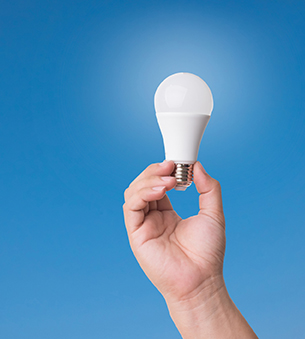Businesses and homes are always looking for ways to save money. The use of LED Lighting is a great way to be more energy efficient. Recently, there has been many improvements in LED Lighting.
 Reduce Energy Use With LED Lighting
Reduce Energy Use With LED Lighting
What is one of the easiest steps you can take to reduce your home or business operating costs? Look to your lighting. While not exactly new to the market, solid state lighting technologies have made huge improvements in quality, output and application in the past five years. New design benchmarks implemented through the Design Lighting Consortium (DLC) has offered some standardization within a marketplace that was considered the Wild West of the lighting world. That is not to say that there is still not a lot of questionable product put onto the market from which the buyer then needs to try and make an decision on what is of quality and what is not.
The vast majority of LED lamps and fixtures are manufactured in China. There are currently over 19,000 factories that manufacture or assemble LED lighting within the country of which only a small percentage actually produce a good quality offering. Many of these other products are sold within “bin” auctions where they end up in products readily found on sites such as Alibaba that will also include ridiculously low shipping charges as well. These products will not be DLC registered nor certified to North American safety standards such as UL. Buyers of these products need to consider very carefully if they are willing to risk issues such as an insurance investigation following an incident in which their compensation coverage is denied to them due to the use of these products.
At the same time, we have large home improvement chains that offer entire aisles of LED lighting with pricing that seems to drop with each weekend special. Consumers will look to these products and think, great, saving electricity, going green for the environment and getting what seems to be a much brighter light than the conventional incandescent lamps they are replacing. They are then perturbed by the quality when the lamp only lasts them a year before it needs to be replaced. What the consumer needs to understand is that the big box home improvement store’s business plan is not based on selling the consumer a lamp or fixture that is going to last ten years. They need constant movement of product off their shelves in order to stay profitable. Read the fine print on the back of the packaging. It will most likely say something to the effect of: 1 (up to 3) years warranty IF used maximum 3-4 hours per day, Must be returned with proof of original purchase and possibly with packaging, Purchaser must send product to “x” location and incur the shipping costs”. Ultimately, the consumer will end up throwing out the lamp, buying a new one and feeling like the whole LED promise is just another example of fake news.
There is a positive size though, with many benefits to an LED lighting switch over or specification of use in a new project. The consumer just needs to be educated enough to know what to look for. Like most things, you get what you pay for.
Let’s Start With The Benefits of LED Lighting
LED Lighting Save Money.
This is true. The average LED equivalent will generally use between ¼ and ½ of the power that their conventional equivalent. As an example, the fluorescent tubes Hollogram utilize consumer 12W of power. They replace a standard T8 tube that is rated at 32W (but will actually use 34W when including the consumption for the ballast.). This same tube will last approximately 2 to 3 times the life expectancy of the Fluorescent tube (that is 2 – 3 time maintenance costs to replace) and we can eliminate the ballast to further reduce the amount of maintenance and replacements required over the life span. When factoring in the energy savings and the maintenance savings offerings, a facility that has high use areas can recognize a return on investment within a very short period of time – under one year for some 24/7 facilities. LEDs have a lifespan well in excess of 60,000 hours (up to 100,000 hours) compared with a marginal 1,500 hours for incandescent bulbs. An LED light will last well over 7 years (with constant use) before needing replacement. On average, LED bulbs last 2 – 3 times as long as fluorescent tubes, 10 times as long as compact fluorescent bulbs, 3 – 6 times as long as HID and MH and 133 times longer than typical incandescent bulbs.
LED’s are different to standard lighting: they don’t really burn out and stop working like a standard light. “Lumen Maintenance” is the term used to describe the amount of light produced at any select elapsed operating time, expressed as a percentage of the initial light output of the lamp. Lumen Maintenance compares the amount of light produced from a brand new lamp to the amount of light output at a specific time in the future. Over an extended period of time, lighting diodes degrade and emit less light. A quality LED can expect to produce over 80% of it’s original lumen output even after 50,000 hours of use. The standard end-of-life for an LED lamp is when the lumen maintenance reaches 70% of its initial output.
Typical Lifespan Scenarios:
- 50,000 hour fixture, powered 4 hours / day: 34 year lifespan
- 50,000 hour fixture, powered 8 hours / day: 17 year lifespan
- 50,000 hour fixture, powered 24 hours / day: 6 year lifespan
Durability:
LEDs are solid state lighting devices that utilize semiconductor material instead of a filament or neon gas. An LED light is a tiny chip encapsulated in an epoxy resin enclosure, which makes LEDs far sturdier than traditional incandescent light bulbs or fluorescent tubes. Since LEDs don’t use fragile components such as glass and filaments, LEDs are able to withstand shock, vibration and extreme impacts. LEDs are suited for all environments and installations. When compared with other lighting technology, LED lamps are better suited for applications involving outdoor lighting, rough conditions, exposure to weather, wind, rain or even external vandalism, traffic related public exposure and construction or manufacturing sites.
Lighting Quality:
LEDs are designed to focus their light and can be directed to a specific location without the use of an external reflector, achieving a higher application efficiency than conventional lighting. In addition, LEDs offer more uniform light coverage when compared to other lighting devices. Well-designed LED illumination systems are thus able to deliver light more efficiently to the desired location.
LEDs also benefit from:
- Dimmable: Most lamps and fixtures can be dimmed through a number of technologies including triac dimming and
step dimming. - Flexibility: LEDs can be combined in any shape to produce highly efficient illumination.
- Color: LED lights are offered in a variety of base colors such as Red, Green, Blue and White resulting in the ability
to produce millions of color options. In addition, white offerings can be produced in any color in the “temperature”
spectrum desired – 2,500 K to 12,000 K (High-Noon daylight is 6,500 K) - Cold Weather Performance: No more waiting, LED lamps are instant on. LED are ideal for operation under cold and low outdoor temperature settings.
- Environment and Safety: LEDs are made from non-toxic materials, unlike fluorescent lighting that uses mercury that pose a significant danger to the environment and people. They also alleviate safety concerns of exposure to mercury vapors, and broken glass, in the case of accidental breakage. LED’s are 100% recyclable and considered “green” or Earth-Friendly.
In addition, LED lights generate virtually no heat therefore they are cool to the touch and can be left on for hours without incident or consequence if touched. LED’s produce 3.4 btu’s/hour, compared to 85 btu’s for incandescent bulbs. In comparison, incandescent lighting expels 90% of the energy it consumes via heat, making the bulbs hot to the touch. LEDs reduce the potential for safety risks such as burns and fires.
Finally, LED illumination produces little infrared light and close to no UV emissions. As a result, LED lighting is highly suitable not only for goods and materials that are sensitive to heat due to the benefit of little radiated heat emission, but also for illumination of UV sensitive objects or materials such as in museums, art galleries, archaeological sites etc.
 Jason Holloway
Jason Holloway
President
Hollogram
162 Gleneagles View
Cochrane, Alberta, T4C 1W2
p: 403.681.8481
e: Jason.Holloway@hollogram.ca

Hollogram’s Differential:
As we noted above, not all lighting is created equal. It is Hollogram’s aims to provide the best, reliable, quality lights that both save money and help save the planet. We are constantly evolving our products and product range to provide the best solutions to not only meet, but also exceed the needs and expectations of our clients. A leader in the solid-state lighting industry, Hollogram is focused on lighting design and supply of quality lighting solutions for commercial, industrial, education, sporting, hospitality, and many other applications. These solutions include direct fixture replacement and retrofitting of existing fixtures with advanced solid-state lighting products. Hollogram is set on providing turnkey solutions with exceptional value and customer support to our clients throughout North America.
Hollogram offers LED products for any solution. From decorative lighting to offices, schools, homes, industrial, or various indoor and outdoor lighting applications, we carry high quality LEDs that are backed with 5-year warranties or longer. Our LEDs have exceptionally long lifespans of 50,000 hours or more, which will last over 21 years in the average workplace environment. All lighting offered is certified to not only DLC standards but all North American (usually UL) standards as well.


